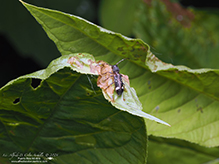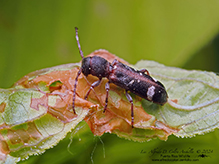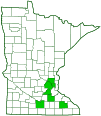currant-tip borer
(Psenocerus supernotatus)
Conservation • Description • Habitat • Ecology • Distribution • Taxonomy
|
|
||||||||||||||
Description |
Currant-tip borer is a small, ant-like, flat-faced longhorn beetle. It occurs in the United States and southern Canada east of the Great Plains. Adults are active from April to July. The larvae are found in decaying branches of various deciduous trees and shrubs. Adults are ⅛″ to 5⁄16″ (4 to 8 mm) in length. The body is elongate, cylindrical, and straight sided. It is somewhat ant-like, but more cylindrical than other ant-like beetles. It is dark reddish-brown to black with white markings. The head is coarsely pitted (punctate). The face is nearly flat. The eyes are notched around the bases of the antennae. The antennae are thread-like and long, almost as long as the body. They have 11 segments. They are colored like the body, and they are slightly darkened at the end of each segment. The plate on the first segment of the thorax (pronotum) is round in outline. It is unmarked and the surface is coarsely punctate. The plate between the wing bases (scutellum) is white. The wing covers (elytra) are rounded at the tip. Each elytron has two oblique white bands, a slender band just before the middle and a wider band on the rear third. Neither band extends to the inner margin (suture). Near the base of each elytron there is a pronounced, raised bump (tubercle). The last part of each leg (tarsus), corresponding to the foot, has five segments, but the fourth segment is minute, and it is concealed between the lobes of the heart-shaped third segment, making it appear that there are only four segments. |
Size |
Total length: ⅛″ to 5⁄16″ (4 to 8 mm) |
Similar Species |
Habitat |
|
Ecology |
Season |
April to July |
Behavior |
Adults are attracted to lights. |
Life Cycle |
|
Larva Hosts |
various deciduous trees and shrubs |
Adult Food |
|
Distribution |
||
|
Sources Biodiversity occurrence data published by: Minnesota Biodiversity Atlas (accessed through the Minnesota Biodiversity Atlas Portal, bellatlas.umn.edu, 6/27/2025). |
|
| 6/27/2025 | ||
Occurrence |
||
|
||
Taxonomy |
|
Order |
Coleoptera (Beetles) |
Suborder |
Polyphaga (Water, Rove, Scarab, Long-horned, Leaf, and Snout Beetles) |
Infraorder |
Cucujiformia |
Superfamily |
Chrysomeloidea (leaf beetles and allies) |
Family |
Cerambycidae (longhorn beetles) |
Subfamily |
Lamiinae (flat-faced longhorn beetles) |
Tribe |
Desmiphorini |
Genus |
Psenocerus |
Subordinate Taxa |
|
|
|
Synonyms |
|
Clytus supernotatus Paralarica picta Psenocerus picta Psenocerus pini Psenocerus supernotatus funebris Psenocerus supernotatus tristis Psenocerus supernotatus var. funebris Psenocerus supernotatus var. tristis Psenocerus tristis |
|
Common Names |
|
currant-tip borer |
|
Glossary
Elytra
The hardened or leathery forewings of beetles used to protect the fragile hindwings, which are used for flying. Singular: elytron.
Pronotum
The exoskeletal plate on the upper side of the first segment of the thorax of an insect.
Scutellum
The exoskeletal plate covering the rearward (posterior) part of the middle segment of the thorax in some insects. In Coleoptera, Hemiptera, and Homoptera, the dorsal, often triangular plate behind the pronotum and between the bases of the front wings. In Diptera, the exoskeletal plate between the abdomen and the thorax.
Tarsus
On insects, the last two to five subdivisions of the leg, attached to the tibia; the foot. On spiders, the last segment of the leg. Plural: tarsi.
Tubercle
On plants and animals: a small, rounded, raised projection on the surface. On insects and spiders: a low, small, usually rounded, knob-like projection. On slugs: raised areas of skin between grooves covering the body.
Visitor Photos |
||
Share your photo of this insect. |
||
This button not working for you? |
||
Alfredo Colon |
||
 |
 |
|
MinnesotaSeasons.com Photos |
||
|
||
|
||

Slideshows |
|

Visitor Videos |
||
Share your video of this insect. |
||
This button not working for you? |
||
|
Other Videos |
||
Psenocerus supernotatus CURRANT TIP BORER preening 3022181 |
About
Jul 24, 2020 Psenocerus supernotatus CURRANT TIP BORER (Longhorn Beetle) preening Dam#4 FP, near Chicago, 6/27/2020.3022181 |

|
Created: 6/27/2025 Last Updated: © MinnesotaSeasons.com. All rights reserved. |


